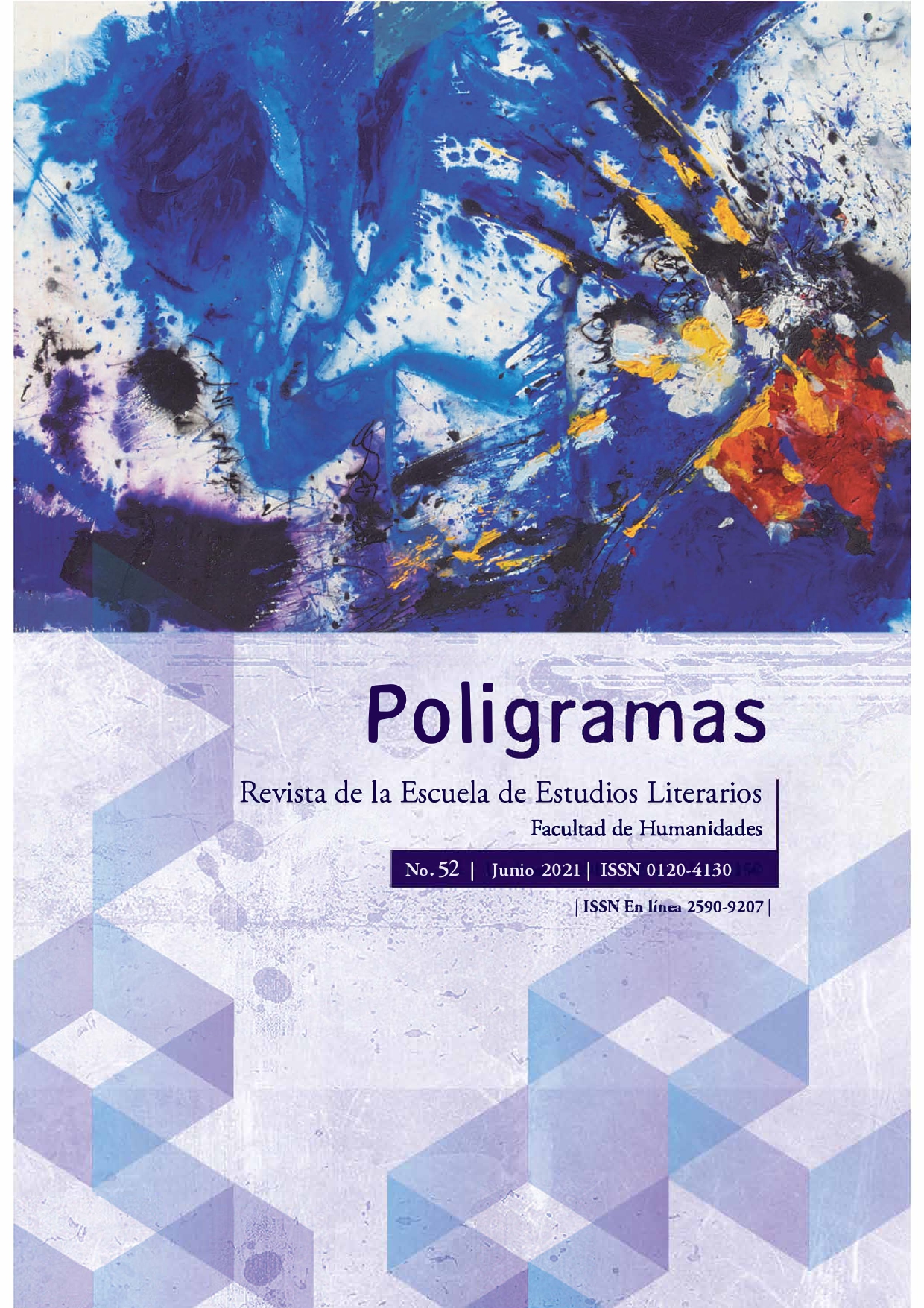Del amor, la pederastia y otros crímenes literarios: América Vicuña y las niñas de García Márquez
Contenido principal del artículo
Los escritores son poderosos. Su palabra juega con nuestras dudas y certezas, dirige, enreda. Como todo gran escritor, nuestro Nobel es, sin duda, un gran seductor, un mago que nos deslumbra, en particular a los caribeños, colombianos y latinoamericanos, por su maestría para reproducir no sólo la historia sino la realidad más íntima de nuestros pueblos; porque nos vemos en sus libros ante un espejo que nos Magnifica, nos hace interesantes, graciosos, dignos de la mirada universal, aún desde nuestras miserias.
- Gabriel García Márquez
- Crímenes lierarios
- Pederastía
- Amor
- Literatura colombiana
Bell-Villada, Gene H, García Márquez. The Man and His Work, University of North Carolina Press, Chapel Hill, 1990.
Beltrán Almería, Luis, “La parodia en El amor en los tiempos del cólera”, Revista de Crítica Literaria Latinoamericana, 23 (46), 1997, pp. 225-234. DOI: https://doi.org/10.2307/4530937
Booker, M. Keith, “The Dangers of Gullible Reading: Narrative as SeductiOn in García Márquez’s Love in the Time of Cholera”, Studies in Twentieth Century Literature, 17(2), 1993, pp. 181-195. DOI: https://doi.org/10.4148/2334-4415.1321
Bryan, T. Avril, “García Márquez’s Perception of the Black as Seen in El amor en los tiempos del cólera”, Afro-Hispanic Review, 7 (1-3), Enero a
Septiembre de 1988, pp. 5-9.
Buehrer, David, “A Second Chance on Earth”: The Postmodern and the Post Apocalyptic in García Marquez’s Love in the Times of Cholera”, Critique: Studies in Contemporary Fiction, 32 (1), 1990, pp. 15-26. DOI: https://doi.org/10.1080/00111619.1990.9933795
Celis, Nadia, La rebelión de las niñas: Cuerpos, poder y subjetividad en la representación de niñas y adolescentes en las escritoras del Caribe hispano, PhD Diss. Rutgers University, New Brunswick, 2007.
Coetzee, J.M., “García Márquez según Coetzee”, trad: Joaquín Ibarburu, Clarín, Marzo 4 de 2006, URL:<http://www.clarin.com/suplementos/
cultura/2006/03/04/u-01151418.htm>
Columbus, Claudette Kemper, “Faint Echoes and Faded Reflections: Love and Justice in the Time of Cholera”, Twentieth Century Literature: A
Scholarly and Critical Journal (TCL), 38 (1), 1992, pp. 89-100.
Cussen, John, “La Beata Laura Vicuña: The Nun’s Version, Corrective of García Márquez’s”, Religion and the Arts, 11, 2007, pp. 373-405. DOI: https://doi.org/10.1163/156852907X244566
Damjanowa, Ludmila, Particularidades del lenguaje femenino y masculino en español, Universidad de Viena, Viena, 1993.
Dio Bleichmar, Emilce, La sexualidad femenina: de la niña a la mujer, Paidós, Barcelona, 1997.
Esparza, Aracely, La vejez como tema en la novelística de Gabriel García Márquez, MA Diss. Texas Tech University, Austin, 2009.
Fahy, Thomas R., Gabriel García Márquez’s Love in the Times of Cholera: A Reader’s Guide, Continuum, New York, 2003.
Fiddian, Robin, “A Prospective Post-script: Apropos of Love in the Times of Cholera”, en: Bernard McGuirk y Richard Carwell, Gabriel García Márquez. New Readings, Cambridge UP, New York, 1987, pp. 191-205. DOI: https://doi.org/10.1017/CBO9780511898006.014
Flores Olea, Víctor,“El amor en los tiempos del cólera: El libro de una educación sentimental”, Cuadernos Americanos, 264 (1), Enero-Febrero de 1986, pp. 202-208.
García Márquez, Gabriel, El amor en los tiempos del cólera, Vintage Books, New York, 2003 [1985].
---, Memorias de mis putas tristes, Grupo Editorial Norma, Bogotá, 2004.
Hunsaker, Steven, “Representing the Mulata: El amor en los tiempos del cólera and Tenda dos milagres.” Hispania, 77 (2), Mayo de 1994, pp. 225-34. DOI: https://doi.org/10.2307/344481
Jacobs, Janet Liebman, Victimized Daughters. Incest and the Development of the Self, Routledge, New York, 1994.
Jones, Anny Brooksbank, “Utopia and Other Commonplaces in García Márquez’s El amor en los tiempos del cólera”, The Modern Language
Review, 89 (3), 1994, pp. 635-644. DOI: https://doi.org/10.2307/3735121
Luiselli, Alessandra, “Los demonios en torno a la cama del rey: pederastia e incesto en Memorias de mis putas tristes de Gabriel García Marquez”, Espéculo. Revista de estudios literarios, Universidad Complutense de Madrid, 32, Mayo de 2007, URL: <http://www.ucm.es/info/especulo/numero32/camarey.html>.
Menton, Seymour. “Ver para no creer: El otoño del patriarca”, en: Peter G.
Earle, Gabriel García Márquez, Taurus, Madrid, 1981, pp. 189-209.
Minta, Stephen, Gabriel García Márquez. Writer of Colombia, Jonathan Cape, London, 1997.
Palencia-Roth, Michael, “Gabriel García Márquez: Labyrinths of Love and History”, World Literature Today: A Literary Quarterly of the University of Oklahoma, Vol. 65 (1), Diciembre de 1991, pp. 54-58. DOI: https://doi.org/10.2307/40146120
---. Gabriel García Márquez: La línea, el círculo y las metamorfosis del mito, Gredos, Madrid, 1983.
Pope, Randolph D, “¿Amor? ¿Tiempo? ¿Cólera?”, en: Jonathan Tittler, Violencia y literatura en Colombia, Orígenes, Madrid, 1989, pp. 81-89.
Rincón, Carlos, La no simultaneidad de lo simultáneo. Postmodernidad, globalización y culturas en América Latina, Universidad Nacional de Colombia, Bogotá, 1995.
Rodríguez-Vergara, Isabel, El mundo satírico de Gabriel García Márquez, Pliegos, Madrid, 1991.
Walkerdine, Valerie, Daddy’s Girl. Young Girls and Popular Culture, Harvard UP, Cambridge, 1997. DOI: https://doi.org/10.1007/978-1-349-25724-9
---. “Popular Culture and the Eroticization of Little Girls”, en: James Curran y otros, Cultural Studies and Communications, Arnold, London, 1996, pp. 323-333.
Descargas

Esta obra está bajo una licencia internacional Creative Commons Atribución-NoComercial-SinDerivadas 4.0.





